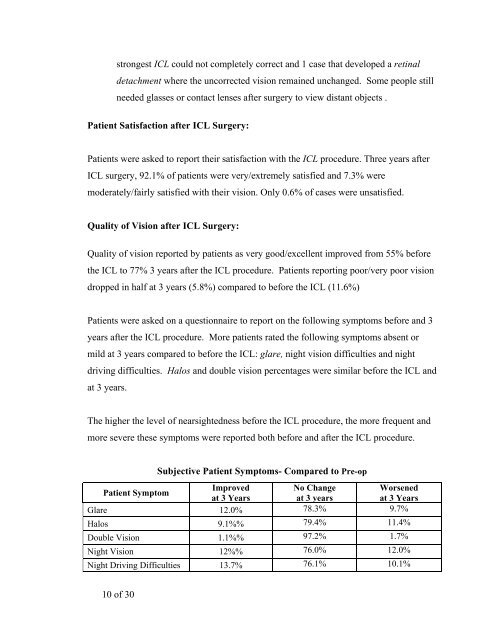ICL Patient Information Booklet
ICL Patient Information Booklet ICL Patient Information Booklet
strongest ICL could not completely correct and 1 case that developed a retinal detachment where the uncorrected vision remained unchanged. Some people still needed glasses or contact lenses after surgery to view distant objects . Patient Satisfaction after ICL Surgery: Patients were asked to report their satisfaction with the ICL procedure. Three years after ICL surgery, 92.1% of patients were very/extremely satisfied and 7.3% were moderately/fairly satisfied with their vision. Only 0.6% of cases were unsatisfied. Quality of Vision after ICL Surgery: Quality of vision reported by patients as very good/excellent improved from 55% before the ICL to 77% 3 years after the ICL procedure. Patients reporting poor/very poor vision dropped in half at 3 years (5.8%) compared to before the ICL (11.6%) Patients were asked on a questionnaire to report on the following symptoms before and 3 years after the ICL procedure. More patients rated the following symptoms absent or mild at 3 years compared to before the ICL: glare, night vision difficulties and night driving difficulties. Halos and double vision percentages were similar before the ICL and at 3 years. The higher the level of nearsightedness before the ICL procedure, the more frequent and more severe these symptoms were reported both before and after the ICL procedure. 10 of 30 Subjective Patient Symptoms- Compared to Pre-op Patient Symptom Improved at 3 Years No Change at 3 years Worsened at 3 Years Glare 12.0% 78.3% 9.7% Halos 9.1%% 79.4% 11.4% Double Vision 1.1%% 97.2% 1.7% Night Vision 12%% 76.0% 12.0% Night Driving Difficulties 13.7% 76.1% 10.1%
4.0 WHAT ARE THE RISKS OF ICL FOR NEARSIGHTEDNESS? Implantation of ICL is a surgical procedure, and as such, carries potentially serious risks. Please review this brochure and discuss the risks with your ophthalmologists. First Week after ICL Surgery: complications reported included: ICL removal and reinsertions (2.5%), shallowness of the front chamber of the eye (0.4%), need for peripheral iridectomy (0.2%), temporary corneal swelling (edema,11.4%) and transient inflammation in the eye or iritis (19.5%). Complications After 1st Week: increase in astigmatism (0.4%), loss of best corrected vision (1.9%), clouding of the crystalline lens (cataract,1.4%), loss of cells from the back surface of the cornea responsible for the cornea remaining clear (endothelial cell loss, 8.9% at 3 years), increase in eye pressure (0.4%), iris prolapse (0.2%), cloudy areas on the crystalline lens that may or may not cause patient symptoms (crystalline lens opacities, 2.7%), macular hemorrhage (0.2%), retinal detachment (0.6%), secondary ICL related surgeries (replacements, repositionings, removals, removals with cataract extraction, 3.1%), subretinal hemorrhage (0.2%), too much or too little nearsightedness correction (2% off by more than 2 D), and additional YAG iridotomy necessary (3.2%). Only 2 eyes (0.5%) lost > 2 lines of best corrected vision (with glasses) compared to 6.5% of eyes that gained > 2 lines of visual acuity with glasses. Of note, only 6.5% of eyes lost 1 line of best corrected visual acuity while 38% of eyes gained 1 line. Potential Complications are not limited to those reported during the clinical study. The following represent potential complications/adverse events reported in conjunction with refractive surgery in general: conjunctival irritation, acute 11 of 30
- Page 1 and 2: 1 of 30 STAAR Surgical Visian ICL
- Page 3 and 4: 3 of 30 TABLE OF CONTENTS 1. Introd
- Page 5 and 6: 1.0 INTRODUC TION The purpose of th
- Page 7 and 8: Wearing glasses and contact lenses
- Page 9: Description of Study Patient Group:
- Page 13 and 14: 6.0 CONTRAIN DICATIONS You should N
- Page 15 and 16: 9.0 ARE YOU A GOOD CANDIDATE FOR IC
- Page 17 and 18: After the iridotomy procedure, your
- Page 19 and 20: 19 of 30 eyeglasses increase over t
- Page 21 and 22: ICL surgery does not eliminate the
- Page 23 and 24: Astigmatic Keratotomy: A type of ey
- Page 25 and 26: Excimer Laser: A type of laser used
- Page 27 and 28: Nearsightedness: A focusing error t
- Page 29 and 30: YAG Laser: (Yttrium Aluminum Garnet
strongest <strong>ICL</strong> could not completely correct and 1 case that developed a retinal<br />
detachment where the uncorrected vision remained unchanged. Some people still<br />
needed glasses or contact lenses after surgery to view distant objects .<br />
<strong>Patient</strong> Satisfaction after <strong>ICL</strong> Surgery:<br />
<strong>Patient</strong>s were asked to report their satisfaction with the <strong>ICL</strong> procedure. Three years after<br />
<strong>ICL</strong> surgery, 92.1% of patients were very/extremely satisfied and 7.3% were<br />
moderately/fairly satisfied with their vision. Only 0.6% of cases were unsatisfied.<br />
Quality of Vision after <strong>ICL</strong> Surgery:<br />
Quality of vision reported by patients as very good/excellent improved from 55% before<br />
the <strong>ICL</strong> to 77% 3 years after the <strong>ICL</strong> procedure. <strong>Patient</strong>s reporting poor/very poor vision<br />
dropped in half at 3 years (5.8%) compared to before the <strong>ICL</strong> (11.6%)<br />
<strong>Patient</strong>s were asked on a questionnaire to report on the following symptoms before and 3<br />
years after the <strong>ICL</strong> procedure. More patients rated the following symptoms absent or<br />
mild at 3 years compared to before the <strong>ICL</strong>: glare, night vision difficulties and night<br />
driving difficulties. Halos and double vision percentages were similar before the <strong>ICL</strong> and<br />
at 3 years.<br />
The higher the level of nearsightedness before the <strong>ICL</strong> procedure, the more frequent and<br />
more severe these symptoms were reported both before and after the <strong>ICL</strong> procedure.<br />
10 of 30<br />
Subjective <strong>Patient</strong> Symptoms- Compared to Pre-op<br />
<strong>Patient</strong> Symptom<br />
Improved<br />
at 3 Years<br />
No Change<br />
at 3 years<br />
Worsened<br />
at 3 Years<br />
Glare 12.0% 78.3% 9.7%<br />
Halos 9.1%% 79.4% 11.4%<br />
Double Vision 1.1%% 97.2% 1.7%<br />
Night Vision 12%% 76.0% 12.0%<br />
Night Driving Difficulties 13.7% 76.1% 10.1%



